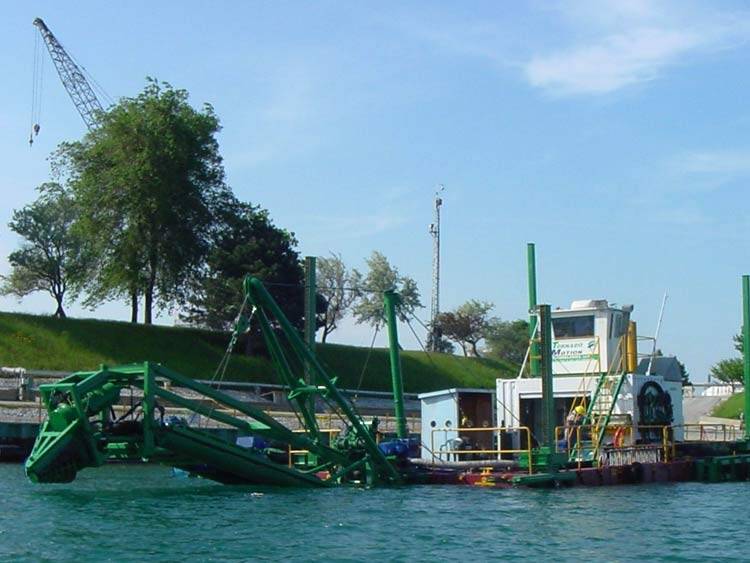In the spring of 2002 EDDY Pump Corporation (EPC ) was selected to conduct a phase 1 pilot project on the St. Clair River. In the past, this particular Project site had been part of a targeted Remedial Action Plan (RAP) shared by Canada and the United States that was identified as one of (42) Areas of Concern AOC) in the Great Lakes Region. Plans to remove the contaminated sediments were then approved by Environment Canada and the Ontario Ministry of Environment (OMOE) and a Certificate of Approval was issued for the work to be done.

The removal of the sediment from the river bottom occurred in three separate phases between May of 2002 and December 2004. The conditions that existed at this industrial site have been documented since the 1950’s and as a result of past historical activities; toxic pollutants became fixed into the sediments that existed offshore. In an area approximately 375,000 sq. ft. sediments containing metals, chlorinated organics and free-phase organic chemicals such as mercury, cadmium, lead, Hexachlorobenzene(HBC), Hexachlorobutidiene(HCBC), Octachlorostyrene, Carbon Tetrachloride and Perchloroethylene had been dumped from an outfall area at the north end of the property. Here, the dredge encountered face cuts over 9-ft. high and a 3-6in layer of Calcium Carbonate to punch through in order to remove those sediments deposited previously and trapped beneath it. The major concern and requirement of this project was that the contaminants were not re-suspended during the dredging operation. Because the St. Clair River is a fast-moving river that supplies drinking water to downstream residents a clean operation is imperative. Silt curtains would be impossible to deploy and therefore EDDY Pump’s ability to conduct a low turbidity operation was essential.
The scope of work specified that EDDY Pump remove the contaminated material that had been deposited on top of the hardpan clay. Daily dive inspections immediately confirmed that the bottom was a sticky soft gray clay and not hardpan which created numerous problems for the dredging operation. Despite the operators best attempts to coordinate the swing and hoist speed to groom the steep side slopes (up to 45°), the basket-shaped head gouged into the slope which resulted in excessive over dredging into the unwanted clay. The rotating head often became plugged with a mixture of sticky clay and debris requiring upwards of a half hour to manually clean. After the short pilot phase was finished there was no doubt that a more efficient method would have to be developed in order to address the conditions of the 3,000 foot long by 125’ wide area of sloped shoreline that would need to be dredged over the 3-year project.
The project team could not find any existing equipment anywhere that was suited to satisfy the requirements of this project so EDDY Pump engineers took on the task. They identified numerous components on the dredge that would have to be changed in order to deal with all the challenges associated with this project and spent the winter of 2002 developing and testing the modifications and then put on a demonstration at our facility in January of 2003 for the project team and the client to evaluate and offer their thoughts. Everyone was impressed and the dredge (Tornado 2) went into phase 2 ready to perform.
The major result of this research and development exercise was a patented compact self-cleaning head that could be articulated in 3 dimensions independently of the main ladder. It is capable of smooth digging under, over, and around obstacles, and on side slopes. When the head is in an automatic articulating mode the head remains parallel with the centerline of the dredge throughout the entire swing.
This creates a level cut even when going up and down slopes which eliminates gouging, windrowing, and over-dredging. Shortly after the modified dredge went into service on phase 2, the divers reported that “it looks like a tennis court down there”.
EDDY Pump’s new environmental dredge system conquered the slope and fulfilled its most important responsibility by not re-suspending contaminants in the water column, Oakland University professor Linda Schweitzer said “The project gets a gold star, “We got as close as 200 feet of the dredge site and there were no suspended sediments in the water. “If we didn’t find anything within 200 feet, they won’t find it 20 miles downstream in drinking water intakes.”
Call For Sales or Support
If you need help with Pump selection, Sales or Engineering Support, Call 619-404-1916
